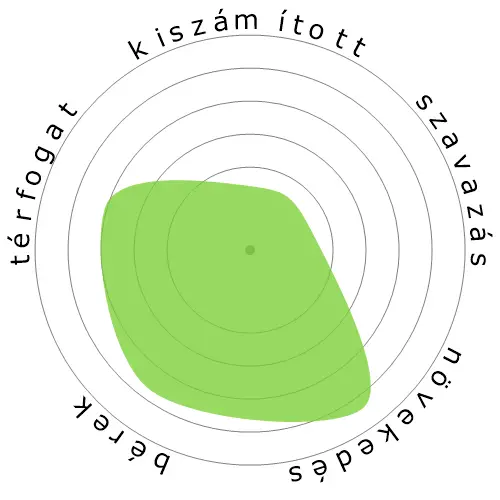Üzleti Intelligencia Elemzők
A Foglalkoztatási Statisztikai Hivatal nem rendelkezik kifejezetten ezzel a foglalkozással kapcsolatos adatokkal, ezért a(z) Data Scientists adatait használjuk.




Az emberek ezt is megtekintették
Számított automatizálási kockázat
Magas kockázat (61-80%): Az ebben a kategóriában található munkák jelentős fenyegetést jelentenek az automatizáció szempontjából, mivel sok feladatukat könnyen automatizálhatjuk a jelenlegi vagy a közeljövő technológiáival.
További információ arról, hogy mi ez a pontszám, és hogyan számítják ki, elérhető itt.
Felhasználói szavazás
Látogatóink szavazatai alapján valószínű, hogy ezt a foglalkozást automatizálni fogják. Ezt az értékelést tovább erősíti a kiszámított automatizálási kockázati szint, amely 74% esélyt becsül az automatizálásra.
Mit gondol, milyen kockázatai vannak az automatizációnak?
Milyen valószínűséggel fogják Üzleti Intelligencia Elemzők robotok vagy mesterséges intelligencia helyettesíteni a következő 20 évben?
Érzelem
A következő grafikon mindenhol szerepel, ahol jelentős mennyiségű szavazat áll rendelkezésre, hogy értelmes adatokat lehessen megjeleníteni. Ezek a vizuális ábrázolások az időbeli felhasználói szavazási eredményeket mutatják, jelentős jelzést adva a hangulat trendjeiről.
Érzelem az időben (évente)
Növekedés
A(z) 'Data Scientists' munkahelyi nyitások száma várhatóan 36,0%-kal nő 2033-ra.
A frissített előrejelzések 09-2025 időpontban esedékesek..
Bérek
A(z) 2023-ban a 'Data Scientists' éves középfizetése 108 020 $ volt, vagyis 51 $ óránként.
'Data Scientists' magasabb összeget kaptak, mint az országos mediánbér, ami 48 060 $-n állt.
Térfogat
2023 időpontjában 192 710 ember dolgozott 'Data Scientists' munkakörben az Egyesült Államokban.
Ez körülbelül a 0,13% -át képviseli az országban foglalkoztatott munkaerőnek.
Másképp fogalmazva, körülbelül minden 787. ember 'Data Scientists'-ként dolgozik.
Munkaköri leírás
Pénzügyi és piaci információkat állít elő az adattárolók lekérdezésével és rendszeres jelentések generálásával. Módszereket dolgoz ki az adatminták és trendek azonosítására a rendelkezésre álló információforrásokban.
SOC Code: 15-2051.01


Megjegyzések
Leave a comment
The bulk of my time as a BI analyst is spent on 2 things. The first is working with domain stakeholders without technical knowledge (marketers in my case). This can often be like herding cats. Lots of people will have lots of different opinions on what KPIs they want to track or how to track them. And often they don't really understand the data limitations of what we can and can't report on, so I need to be there to provide guidance. Much of my job is spent guiding these people along, often massaging their egos along the way, so that the wider group of people arrives at a consensus.
The second is ETL. Even with whole teams of data engineers and operations managers, data is very rarely centralised into a single and easy to understand model. I work with about half a dozen different types of data sources (from AWS to Google Sheets). Each of these have hundreds of different indexes and many of those indexes have hundreds of fields. A tiny fraction of these fields have any kind of documentation and so all you have to go on is the metadata and the name of the db managers who put it together. Actually tracking down the data you need requires getting really into the weeds and following up with multiple people to try to track down who actually knows where to find the data you're looking for. That's just nowhere near enough data for an AI to get a hold of the data it needs.
It is a field where people usually believe in other people rather than AI.
The ETL process is also a complicated, one which most AI is not nor ever may be able to handle, data needs to be cleaned and standardized before AI can take a crack at it, the "AI" and yes I have to put that in quotes does not understand the context of anything, it is a prediction model using gradient boosters that performs quite well under controlled circumstances, thrown into any critical thought role it starts to lose pace. Furthermore nobody who works in the AI space authoring models ands understands the inner workings of "AI" treats this as anything more than a highly sophisticated toy...maybe in another 10 years we can come back to this question and see if we should start to worry.
I spend half of my time maintaining, tweaking, and fixing automation jobs - these include dashboards, data sets, and database tables.
It requires a technical person who is also an expert in their business domain to translate business requirements into data or reports that others need.
Hagyjon egy választ erről a foglalkozásról